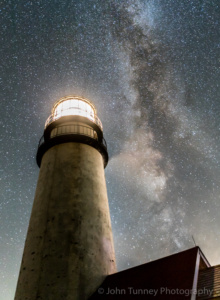 The best lenses for photographing the Milky Way are fast wide-angles. By “fast” I mean a lens with an f-stop of f2.8 or lower. You can get away with an f4 lens, but an f2.8 lens is better. Every full stop down collects twice as much light as the previous stop. So an f2.8 lens will collect twice as much light as an f4 lens. This means you can use a lower iso, which means less noise. It also mean you can opt for a shorter shutter speed, which means less streaking of the stars.
The best lenses for photographing the Milky Way are fast wide-angles. By “fast” I mean a lens with an f-stop of f2.8 or lower. You can get away with an f4 lens, but an f2.8 lens is better. Every full stop down collects twice as much light as the previous stop. So an f2.8 lens will collect twice as much light as an f4 lens. This means you can use a lower iso, which means less noise. It also mean you can opt for a shorter shutter speed, which means less streaking of the stars.
Wide Angles
A wide-angle lens will let you capture more of the sky and include foreground elements for a better composition. For full-frame cameras, stick with 24mm or less. You can get nice shots with longer focal lengths, especially if you shoot to stitch a panoramic, but 24mm or less will generally give you the most pleasing single-shot results.
For APS-C cameras, stick in the 10-16mm range. This will give you the full-frame equivalent of roughly 15-24mm.
When researching lenses, check what they say about coma – comatic aberration. It stretches points of light, like stars, at the edge of the frame, giving them “wings”. Most lenses have some coma, especially the super wide and fast lenses, but less is better.
Below are some lenses recommended specifically for astrophotography. These are all lenses that I own or have owned, or would consider buying.
For full-frame and crop cameras
Samyang/Rokinon – Samyang sells lenses under both the Rokinon and Samyang brand. They are all the same lenses. Samyang/Rokinon lenses are budget-friendly lenses for astrophotography. Some people have complained that there a quality control issues, with variations from sample to sample. I’ve owned three Samyang/Rokinon lenses and never had a problem.
Rokinon 14mm f2.8 – This is a classic among night photographers. Samyang makes two versions – a manual focus and an autofocus. At under $300, the manual focus is a bargain and a great entry-level lens for astrophotography. The autofocus version also comes with weather sealing and runs about $800.
Rokinon 14mm SP (Special Performance) f2.4 – The 14mm f2.4 SP is faster, sharper and has better build quality than the f2.8 version. Manual focus. I own this lens and like it. About $800.
Sigma 14mm f1.8 Art – Super fast and sharp. Autofocus. $1489.
Tamron 15-30mm f2.8 – This has become a very popular lens for astrophotography. I haven’t used it yet, but it gets great reviews, and is on my short list. $1099.
For full frame only
Samyang 24mm f1.8 – Super fast and very sharp. The picture at the top of the page was shot with this lens. Manual focus. $400-$500.
For crop sensors only
Sigma 18-35mm f1.8 – Fast and sharp. Autofocus. About $800.
Tokina 11-20mm f2.8 – Fast and good focal length. Autofocus. About $500.
Rokinon 16mm f.2 – Like the Rokinon 14mm for full frame cameras, the 16mm is class entry-level lens for astrophotography. Manual focus. About $350.
# # #